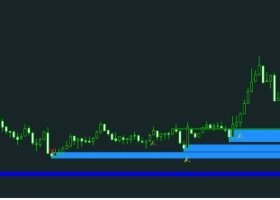Introduction to the Megaphone Pattern (Broadening Top)
- The megaphone pattern, also known as the broadening top pattern, involves price making higher highs AND higher lows.
- As such, it is indicative of greater volatility and instability in the market.
- Specifically, traders should look for five points: a high (point A), a low (point B), a high that is higher than point A (this is point C), a low that is lower than point B (this is point D), and a high that is higher than point C (this is point E).
- Typically, the pattern emerges at the end of an uptrend and is a sign that the market is headed down.

A Megaphone Top is a relatively
rare formation and is also known as a Broadening Top. Its shape is
opposite to that of a Symmetrical Triangle. The pattern develops after a
strong advance in a stock price and can last several weeks or even a
few months.
A Megaphone Top is formed because the
stock makes a series of higher highs and lower lows. The Megaphone Top
usually consists of three ascending peaks and two descending troughs.
The signal that the pattern is complete occurs when prices fall below
the lower low.
Volume in the Megaphone Top usually peaks along
with prices. It is usual to see trading volumes increase or remain high
during the formation of this pattern. The eventual breakout and reversal
can be difficult to identify at the time of its occurrence because
volume does not appear unusual.
The target price provides an important indication about the potential price move that this pattern indicates. Consider whether the target price for this pattern is sufficient to provide adequate returns after your costs (such as commissions) have been taken into account. A good rule of thumb is that the target price must indicate a potential return of greater than 5% before a pattern should be considered useful, however you must consider the current price and the volume of shares you intend to trade.



